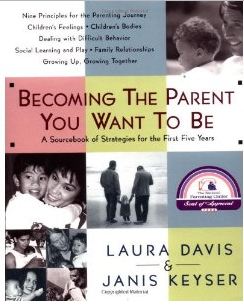Janis Keyser, author of Becoming The Parent You Want To Be, opened her talk Parenting Is A Journey by sharing that Laura Davis, who is the co-author of the book, lobbied hard for titling the book Become The Parent You Want To Be. Janis argued that they couldn’t name the book Become The Parent You Want To Be because “no one will ever do it.” She explained, “It’s impossible to become the parent you want to be, because parenting is a process, one that you approach day by day. It’s about becoming.” She noted that there really is no easy way to prepare to be a parent. “You can care for or teach other people’s children, but the real “training” comes once you become a parent. It’s on the job training, when you are sleep deprived and there is no time.” And if you are a parent to more than one child, “each child asks of you to be a different parent.”
Let Go of Perfection
Perfection is not the goal. It’s about letting go of perfection, and being with what is. “Children give us a second chance to see the world with fresh eyes.”
“Perfect parents are not useful for children, because perfect parents don’t model how you make a mistake, and what you do next.” “I’m sorry. I didn’t mean to do that. I made a mistake. I will try to do that in a different way the next time.” Children think adults are so competent. They think you know everything. What a wonderful example you set when you model for them: “You can be as big and as competent as I am, and still be learning.”
Define Values
“HERE is Edward Bear, coming downstairs now, bump, bump, bump, on the back of his head, behind Christopher Robin. It is, as far as he knows, the only way of coming downstairs, but sometimes he feels that there really is another way, if only he could stop bumping for a moment and think of it.” A.A. Milne
Janis said this scene from a Winnie The Pooh story is a good analogy for parenting. You go bumping along from day to day doing the best you can. It may be the only way you know, but sometimes you may have an inking that there might be another way, if only you had a moment to stop and think about it! Learning about, and understanding how your child develops can help you, as can taking time to reflect on the values you want to teach. Take the time to stop for a moment and consider how you’d answer these two questions (we did this exercise in the workshop):
1) Imagine your your child as a twenty year old. If you asked him to complete the following sentence what would you want him to say? (Try to think of five things you’d want him to say he learned.) In my family I learned:
2) Now, can you think of one example, or one way that you transmitted one of these values to your child this week?
It can also be helpful to reflect upon what you learned in your family, and to ask yourself if these are values you want to pass on to your children. Often times, you may find you unconsciously parent exactly like your parents or exactly the opposite of your parents. You may find that you share similar values, but have a different way of teaching them. Janis, who is the mother of three, stepmother to five, and grandmother to many children, was reminded of this one day when her late husband said to her, “You can send your mother home now,” but her mother wasn’t visiting. Her husband’s words made Janis realize she was acting like her mother in a particular instance.
Our children learn from every single interaction they have with us, even the hard ones. We are always sending messages, both implicit and explicit through every exchange we have with our children. It’s not just our tone of voice and what we say that conveys our values, but also what we do, and the spirit in which we do it. To illustrate this point, Janis told a story about one of her daughters who had been going through an extended period of experiencing intense temper tantrums. Janis was feeling like nothing she was doing was helping her daughter. One day, in frustration, she asked her daughter what she could do to help her, because she didn’t know. Her daughter thought about it for a moment and said, “What you already do. Hold me. Keep me safe. Stay until I’m done. Listen to me.” Janis realized then that her daughter was getting the message she wanted to send, even though she was still struggling.
Janis’s four year old son once had a fascination with guns, and one day he constructed a toy gun out of legos, and came to show her. His explanation to her was that the gun he made shot the guns out of the bad guys’ hands and made them peaceful. At the age of four, her son understood that if he was going to talk with Janis about guns, the conversation somehow had to include peace.
Another time, her thirteen year old daughter wanted to attend a movie that Janis wasn’t sure was appropriate. As Janis was debating whether or not to let her daughter go to the movie, she suggested maybe she would go to the movie with her daughter. Her daughter”s response? “Mom you don’t need to go to the movie with me. Your voice is already in my head!”

Share Values Through Relationship
We tell our children what it is they can talk about through opening up the conversation, not through correcting, but through listening, and through sharing our own feelings. If we don’t talk about and share our feelings, then children learn not to talk about feelings. Janis talked about being a “champion crier” as a small child, yet as she grew up she internalized the message “Big girls don’t cry.” She was never told to stop crying, and her mother sometimes cried, but when her mother cried it was always clear that she was disappointed in herself . To this day, when Janis’s mother calls to talk with her, Janis is always “Fine!” (said with a great big smile), no matter how she feels or what is happening in her life.
We can show interest in our children’s experience, by trying to understand the thinking behind their thinking. “Tell me more.” “How do you think that happens?” The conversation between parent and child is ideally a give and take. When a Mom takes the time to slow down and share in her child’s fascination with watching a catepillar, this is seemingly a small gesture, but here are some of the messages the child might receive in that moment: “Simple shared moments can bring joy.” “What I notice is important.” ” What I am motivated by is interesting to those who love me.” “Sharing a discovery is even better than making a discovery on my own.” “I can learn more through patient observation than by quickly moving on.”
Understand Development and Embrace the Struggle
“There are a few things you can’t make a child do. You can’t make them eat, sleep, or poop on the potty. What you can do is set up the context, create the space, and provide rhythm, and predictability.”
Discipline is one of the greatest gifts we can give children. Boundaries can be created in a respectful and honoring way. “The reason children are given parents is so they can set limits because children don’t always have the experience to make all the best decisions at the moment.” They can learn to make good choices in time, with practice, and within the safe parameters parents provide. The key to setting a limit respectfully is to ask yourself “What is the good idea that my child has? What is she trying to express, and how can I help her to figure out how to express this idea in a positive way?” For instance, a child who is biting may be trying to express, “I’m teething, it hurts, and it feels really good to chomp on your arm.” Or maybe it’s, “I really want the toy you have in your hand.” Or maybe it’s, “I feel crowded when you get too close.” Or maybe it’s even, “I love you so much, I could just bite you!”
Acknowledge the good idea (what the child is trying to express). “You are feeling crowded. You want some space.” Give information: “You may move away, or tell Emily to stop if she’s coming too close.” Create safety using both physical and verbal boundaries: “I am here to help you and to keep everyone safe.” Place a hand between two children to prevent a bite. In the case of a child who is biting because of feeling crowded, maybe you stay close to provide narration, or set up a private, quiet space the child can retreat to, or maybe you avoid attending group events for a time. Give redirection and choices: “I can’t let you bite Emily, but you may bite one of these teething toys if you need to bite.” Acknowledge progress:”You were feeling frustrated when Emily got too close today, but you didn’t bite! You moved away!” Give the message, “I know you are learning and growing into a person who can express feelings and get your needs without hurting anyone.”
Redefine your role as a coach or facilitator. Honor the process, the struggle, the frustration. “What would it be like if your child was in the middle of a struggle and you were her cheerleader? Ask yourself if there is a way to help your child have a positive, deeply healthy relationship to their struggle, to their feelings, to ALL of them, not just the happy ones.” With your guidance, and modeling, your child can learn to move through feelings to find accomplishment on the other side, and “the next 100,000 times a struggle presents itself, they will have this experience to draw upon.”
In this post, I’ve shared the highlights of Janis Keyser’s April 24th,2012, talk, Parenting Is A Journey, given at The Third Place in Los Altos, California. Janis is a teacher, parent educator, program director and speaker who specializes in Early Childhood Development. She taught for 30 years in the Early Childhood Education Department at Cabrillo College and has been conducting workshops for parents and teachers for over 35 years. She is a nationally recognized speaker at parenting, family and child development conferences. She lives in Santa Cruz, California and is the mother of three, stepmother of five, and grandmother of many.
